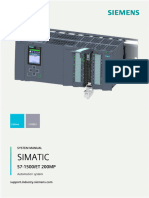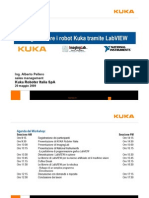NetToPLCsim - Network extension for Plcsim
Thomas Wiens
February 2, 2016
NetToPLCsim - Network extension for Plcsim
by Thomas Wiens
�LIST OF TABLES
CONTENTS
Contents
1
Introduction
1.1 What you can do with NetToPLCsim . .
1.2 What you cannot do with NetToPLCsim
1.3 How does NetToPLCsim work? . . . . .
1.4 S7online-interface . . . . . . . . . . . . .
.
.
.
.
.
.
.
.
.
.
.
.
.
.
.
.
.
.
.
.
.
.
.
.
.
.
.
.
.
.
.
.
.
.
.
.
.
.
.
.
.
.
.
.
.
.
.
.
.
.
.
.
.
.
.
.
.
.
.
.
.
.
.
.
.
.
.
.
.
.
.
.
.
.
.
.
1
1
1
1
2
Manual
2.1 Quickstart . . . . . . . . . . . . . . . . . . . . . . . . . . . .
2.1.1 Plcsim with S7-300/S7-400 (Step 7 V5.5, TIA-Portal)
2.1.2 Plcsim with S7-1200/S7-1500 (TIA-Portal) . . . . . .
2.2 General operation . . . . . . . . . . . . . . . . . . . . . . . .
2.2.1 Neccessary requirement . . . . . . . . . . . . . . . .
2.2.2 Main window . . . . . . . . . . . . . . . . . . . . . .
2.2.3 Station dialog . . . . . . . . . . . . . . . . . . . . . .
2.2.4 Protocolmonitor . . . . . . . . . . . . . . . . . . . . .
2.2.5 Command-line arguments . . . . . . . . . . . . . . .
2.3 Further informations . . . . . . . . . . . . . . . . . . . . . .
2.3.1 Multiple Plcsim-Instances . . . . . . . . . . . . . . .
2.3.2 Simatic S7DOS service . . . . . . . . . . . . . . . . .
.
.
.
.
.
.
.
.
.
.
.
.
.
.
.
.
.
.
.
.
.
.
.
.
.
.
.
.
.
.
.
.
.
.
.
.
.
.
.
.
.
.
.
.
.
.
.
.
.
.
.
.
.
.
.
.
.
.
.
.
.
.
.
.
.
.
.
.
.
.
.
.
.
.
.
.
.
.
.
.
.
.
.
.
.
.
.
.
.
.
.
.
.
.
.
.
.
.
.
.
.
.
.
.
.
.
.
.
.
.
.
.
.
.
.
.
.
.
.
.
.
.
.
.
.
.
.
.
.
.
.
.
.
.
.
.
.
.
.
.
.
.
.
.
.
.
.
.
.
.
.
.
.
.
.
.
.
.
.
.
.
.
.
.
.
.
.
.
.
.
.
.
.
.
.
.
.
.
.
.
.
.
.
.
.
.
.
.
.
.
.
.
.
.
.
.
.
.
.
.
.
.
.
.
.
.
.
.
.
.
.
.
.
.
.
.
2
2
2
2
2
2
3
4
4
5
6
6
7
Version history
3.1 Version 0.9.0
3.2 Version 0.9.1
3.3 Version 0.9.2
3.4 Version 0.9.3
3.5 Version 0.9.4
3.6 Version 0.9.5
3.7 Version 1.0.0
3.8 Version 1.1.0
.
.
.
.
.
.
.
.
.
.
.
.
.
.
.
.
.
.
.
.
.
.
.
.
.
.
.
.
.
.
.
.
.
.
.
.
.
.
.
.
.
.
.
.
.
.
.
.
.
.
.
.
.
.
.
.
.
.
.
.
.
.
.
.
.
.
.
.
.
.
.
.
.
.
.
.
.
.
.
.
.
.
.
.
.
.
.
.
.
.
.
.
.
.
.
.
.
.
.
.
.
.
.
.
.
.
.
.
.
.
.
.
.
.
.
.
.
.
.
.
.
.
.
.
.
.
.
.
.
.
.
.
.
.
.
.
.
.
.
.
.
.
.
.
8
8
8
8
8
8
8
9
9
.
.
.
.
.
.
.
.
.
.
.
.
.
.
.
.
.
.
.
.
.
.
.
.
.
.
.
.
.
.
.
.
.
.
.
.
.
.
.
.
.
.
.
.
.
.
.
.
.
.
.
.
.
.
.
.
.
.
.
.
.
.
.
.
.
.
.
.
.
.
.
.
.
.
.
.
.
.
.
.
.
.
.
.
.
.
.
.
.
.
.
.
.
.
.
.
.
.
.
.
.
.
.
.
.
.
.
.
.
.
.
.
.
.
.
.
.
.
.
.
.
.
.
.
.
.
.
.
.
.
.
.
.
.
.
.
.
.
.
.
.
.
.
.
.
.
.
.
.
.
.
.
.
.
.
.
.
.
.
.
.
.
.
.
.
.
.
.
.
.
.
.
.
.
.
.
.
.
.
.
.
.
.
.
.
.
.
.
.
.
.
.
.
.
.
.
.
.
.
.
.
.
.
.
.
.
.
.
.
.
.
.
.
.
.
.
.
.
.
.
.
.
.
.
.
.
.
.
.
.
.
.
.
.
.
.
.
.
.
.
.
.
.
.
.
.
.
.
.
.
.
.
.
.
.
.
License
List of Figures
1
2
3
4
5
6
NetToPLCsim Main window . . . . . . . . . . . . . . . . . . . . . .
NetToPLCsim Station dialog . . . . . . . . . . . . . . . . . . . . . . .
NetToPLCsim Protocolmonitor . . . . . . . . . . . . . . . . . . . . .
Simulation of three Plcsim instances . . . . . . . . . . . . . . . . . .
Adding an IP address to a network interface (Windows 7) . . . . . .
Example configuration in NetToPLCsim for three Plcsim instances
.
.
.
.
.
.
.
.
.
.
.
.
.
.
.
.
.
.
.
.
.
.
.
.
.
.
.
.
.
.
.
.
.
.
.
.
.
.
.
.
.
.
.
.
.
.
.
.
.
.
.
.
.
.
.
.
.
.
.
.
.
.
.
.
.
.
.
.
.
.
.
.
.
.
.
.
.
.
3
4
5
6
6
7
Command-line arguments . . . . . . . . . . . . . . . . . . . . . . . . . . . . . . . . . . . . .
List of Tables
1
ii
INTRODUCTION
Introduction
1.1
What you can do with NetToPLCsim
NetToPLCsim allows you to use network communication together with the PLC-Simulation S7-Plcsim,
using the network interface of the PC on which the simulation is running. For example, you can test
your client application (SCADA system, etc.) together with S7-Plcsim, without a real PLC.
NetToPLCsim supports most of the functions which are supported by S7-Plcsim, like:
Tag services: reading and writing data areas
Block services: Program upload, program block online view, . . .
Block specific messages with Alarm_S, Alarm_D
Support of multiple Plcsim instances on a single computer
1.2
What you cannot do with NetToPLCsim
The following functions are known not possible with NetToPLCsim:
All communication functions which are programmed via the T-Blocks (TCON, TSEND, etc.) or via
NetPro configured are not supported
NetToPLCsim supports other system state lists (SSL/SZL) as a real CPU, and they contain different
values
You cant use programming functions using using TIA-Portal with a S7-300/400 simulation, because TIA-Portal checks the compatibility of the CPU you want to upload the program to. With
Step7 V5.x this is no problem, as its more tolerant to upload the program into a different type of
CPU
The Plcsim/NetToPLCsim CPU will not be visible if you are using "Display Accessible Nodes" in
Step 7. This method uses the LLDP protocol on MAC layer. On a PC with installed Simatic software, your PC will always be listed as "PC-Station". Furthermore the communication behaviour
of S7-Plcsim/NetToPLCsim is slightly different to a real CPU.
I MPORTANT
A test with NetToPLCsim does not substitute the test on the real hardware.
1.3
How does NetToPLCsim work?
The first versions of NetToPLCsim (including V0.7.2) were using the official interface to Plcsim, which
is a library implemented in the so called S7ProSim-COM-object. In this versions the S7 protocol was
processed inside NetToPLCsim, and the requested data were read or written to Plcsim through this
interface. Due to the limitation in this interface, to get only access to data areas, is was only possible
to realize tag services with NetToPLCsim. Another disadvantage of the S7ProSim interface is, that its
rather slow.
Plcsim for 1200/1500 has no interface like S7ProSim. Due to this limitations, all following versions
are using the so called S7online-interface.
MANUAL
1.4
1.4
S7online-interface
S7online-interface
The S7online-interface represents the OSI layers 1 to 4 for all applications inside the Simatic universe.
If a Simatic application communicates to a PLC, the data goes always through the S7online-interface.
The functions of the S7online-interface are accessible through the program library s7onlinx.dll inside
the windows system directory.
The S7online-interface passes the data from the application to the underlying transport layer, like
TCP/IP, MPI or Profibus. The transport layer which S7online is using, is configured in the dialog
"Set PG/PC interface" from the Simatic application or the Windows control panel. Also the communication to Plcsim runs through this interface. The data running through this interface are already S7communication. Thus the job of NetToPLCsim is to represent the IP/IsoOnTcp transport layer, and pass
the payload into the S7online-interface and back. The main problem with the S7online-interface is that
its not official documented, which was the main problem using this interface with NetToPLCsim.
Manual
2.1
Quickstart
2.1.1
Plcsim with S7-300/S7-400 (Step 7 V5.5, TIA-Portal)
Use the following steps to setup a network accessible Plcsim simulation using NetToPLCsim. The description is valid for Plcsim with Step 7 V5.5.
1. Start the Simatic manager
2. Open your S7 project you want to test
3. Start Plcsim, upload the program including system data into Plcsim. You need a CPU with a
ethernet network device (PN-CPU or CPU plus Ethernet CP)
4. Start NetToPLCsim with administrative rights (these are neccessary to stop a Siemens service)
5. If NetToPLCsim asks to stop the Siemens service, click yes
6. In NetToPLCsim click on "Add"
7. In the station configuration dialog, click on ". . . " next to the text field "Network IP Address". You
get a list with all IP addresses of the existing network devices of your computer. Choose the
address on which Plcsim should be accessible
8. Next to the text field "Plcsim IP Address" click on ". . . ". You should see the Plcsim CPU you have
uploaded. Select the device and click "OK"
9. Set a rack/slot combination of 0/2 (for S7-400 dependant of your hardwareconfiguration
10. Close the dialog with "OK"
11. In the main window click on "Start server"
12. Your Plcsim simulation is now reachable at the IP address shown under "Network IP address"
2.1.2
Plcsim with S7-1200/S7-1500 (TIA-Portal)
To use NetToPLCsim with TIA-Plcsim, its required to set the correct PG/PC interface settings. In
the Windows Control Panel you open the "Set PG/PC interface" program, and set the access point for
S7ONLINE to "PLCSIM S7-1200/S7-1500(TCP/IP)".
2.2
General operation
2.2.1
Neccessary requirement
You need Step 7 Plcsim with V5.4 or later, or Plcsim for TIA-Portal.
In your Step 7 hardware configuration you must have an Ethernet device (PN-CPU or CPU plus
Ethernet CP).
2
MANUAL
2.2.2
2.2
General operation
Main window
Figure 1 NetToPLCsim Main window
1. Area showing your configured stations
2. Buttons to start and stop the server for the configured stations
3. Buttons to add, modify or delete a station
4. Result of the port-check which is done on start of NetToPLCsim. You can use NetToPLCsim only
with status OK.
MANUAL
2.2.3
2.2
General operation
Station dialog
Figure 2 NetToPLCsim Station dialog
1. Unique Name
2. IP address of the network interface at which this server should be reachable
3. IP address of the Plcsim-CPU
4. Rack/Slot position of the CPU. This setting is only relevant if you set the option TSAP-check.
If you enable this option, your client application needs to use the correct TSAP corresponding
to the rack/slot combination. NetToPLCsim accepts as connection ressource 1=PG, 2=OP and
3=Step7Basic.
2.2.4
Protocolmonitor
If you have started the NetToPLCsim server, you can start the protocolmonitor via context menu (right
mouse-click) of the station you want to monitor. If you select "Start monitoring", a new window with
the protocolmomitor opens.
At this time only S7 communication for S7-300/400 is shown, and only some parts of the S7 protocol
are dissected. Only incoming telegrams using variable services (reading and writingdata areas in the
S7) and SSL-(SZL)-Requests are decoded.
With mouseclick on the statusbar, you can pause and resume the capture output. The communication
is not stopped when you pause the output.
If you want to see all details of the S7 protocol, you can use the network protocol analyzer Wireshark.
Since Wireshark version 2.0 the S7 protocol is integrated. On older versions you need a plugin-dll for
the S7 communication, you can download from the link below.
http://sourceforge.net/projects/s7commwireshark
MANUAL
2.2
General operation
N OTE
The activated monitoring reduces the data exchange rate significant.
Figure 3 NetToPLCsim Protocolmonitor
2.2.5
Command-line arguments
You can use the following command-line arguments with NetToPLCsim:
Table 1 Command-line arguments
Option
-f=config.ini
-s=Option
Description
Loads this station configuration file
Autostop control of the S7DOS Help
Service. Options: YES=Stop the
service, NO=Dont stop the service,
ASK=ask
If a valid configuration-file is loaded,
the servers for the stations in the file
are automatically started
-autostart
Example:
NetToPLCSim.exe -f=testconfig.ini -s=NO -autostart
Further its possible to Drag&Drop a configuration file on the NetToPLCsim.exe file. Then NetToPLCsim starts and loads this configuration.
MANUAL
2.3
Further informations
2.3.1
Multiple Plcsim-Instances
2.3
Further informations
The following example demonstrates how to realize three network reachable Plcsim instances with NetToPLCsim. The main principle could be extended to a arbitrary number of additional instances (tested
with 6 Plcsim instances).
Figure 4 Simulation of three Plcsim instances
Each Plcsim instance needs its own IP address, under which its later reachable from your network.
One option is that youve got more than one network interface in your computer. The other option is to
add one or more IP addresses to the existing network interface.
In the following screenshot, it is shown how to add an additional IP address to your network interface under Windows 7 (german).
Figure 5 Adding an IP address to a network interface (Windows 7)
MANUAL
2.3
Further informations
N OTE
To avoid later network problems, you should delete the additional IP-addresses when
finished with testing.
You can start a new Plcsim instance after you started the first instance, using the menu "File"
"New Plc" in Plcsim. When the new Plcsim instance has started, upload the PLC program including
system data into Plcsim. Only with uploaded system data the simulation has the configured "virtual" IP
address.
The setup of the stations in NetToPLCsim is done in the same way as described for a single station.
For the simulation overview shown above the following setup in NetToPLCsim is needed:
Figure 6 Example configuration in NetToPLCsim for three Plcsim instances
2.3.2
Simatic S7DOS service
The S7-communication uses TCP port 102.
If you have Step 7 installed on your system, youve got a service called "SIMATIC S7DOS Help
Service" (old name was "SIMATIC IEPG Helper"). This service listens on all available network interfaces
for incoming connections on TCP port 102. Thus as long this service is running, its not possible to start
an server from another application like NetToPLCsim using this port.
Since Step 7 V5.5 SP2 unter 64 bit Windows, its no longer possible to simply stop the service, as this
affects other Siemens program functions.
For that reason the function "Get Port 102" from Tools-Menu, and the automatic service-stop function
when you start NetToPLCsim (since version 1.1.0) starts the following sequence:
1. Stop the service "SIMATIC S7DOS Help Service"
2. Start own TCP server on port 102 on all available interfaces
3. Start the service "SIMATIC S7DOS Help Service". As TCP port is now not available for the service,
it cannot reserve it
4. Stop own TCP server
5. Check if TCP port 102 is now available If the last check succeeded, port 102 is now available for
using with NetToPLCsim.
VERSION HISTORY
NetToPLCsim remembers when you have stopped the Siemens service on program start. If you close
NetToPLCsim, you can optional restart the Siemens service (recommended).
N OTE
If you want to program a real S7-PLC after testing with NetToPLCsim, its recommended
to restart the computer!
Version history
3.1
Version 0.9.0
First version using the S7online interface
3.2
Version 0.9.1
added optional monitoring of the data-exchange
3.3
Version 0.9.2
Fixed: Data exchange with Plcsim doesnt hang up any more, when packets of some special PDU
sized occur
Check of the running IEPG-Helper servicename to stop/start service in Windows 32 or 64 Bit OS
Added Command-line Arguments, and the possibility to Drag&Drop a configuration file on the
NetToPLCsim.exe
3.4
Version 0.9.3
Temporary fix: Implemented own response for SZL-ID 0x0131 index 3 request, to force clients not
to use the cyclic data exchange mechanism, which causes sometimes communication failures
Usability: Automatic name generation when a new station is added
3.5
Version 0.9.4
NetToPLCsim answers a client that only one single request at time can be handled (MaxAmQCalling/MaxAmQCalled)
Added optional setting for rack/slot combination of CPU (maybe possible to connect to TIAPortal
Plcsim)
Added option for TSAP check corresponding to entered rack/slot. Connection ressources 1, 2 or 3
are valid (1=PG, 2=OP, 3=S7basic)
Protocol monitor: requested index and ID of SZL requests are shown
3.6
Version 0.9.5
Adding Tool "Get Port 102" in Menu Tools, which helps to get NetToPLCsim working under Step
7 V5.5 SP2 and Windows 64 Bit
LICENSE
3.7
3.7
Version 1.0.0
Version 1.0.0
Redesign of handling the S7online interface. NetToPLCsim supports now the full functionality of
Plcsim. Programming functions like up- and downloading of program blocks and online diagnostics are possible. Also block-specific messages like ALARM_S, ALARM_8 and cyclic variable
services are supported.
Added own response telegram to SZL-ID 16#0x74, used to get the LED state of the CPU. Independent of the operating mode, the response is always RUN-LED on, and all other LEDs off.
3.8
Version 1.1.0
Fixed: if many ISO packets were sent in a single TCP telegram, this may have caused an exception
and disconnect (for V.1.0.0)
Added support to S7-Plcsim for TIA-Portal S7-1200/1500
Function "Get Port 102" from tools-menu is now executed on program start to stop the Siemens
service
Monitor window: With mouseclick on statusbar the capturing can be paused and resumed
New documentation using Windows-Help files
Changed license from GPL to LPGL
License
NetToPLCsim is free software: you can redistribute it and/or modify it under the terms of the GNU
Lesser General Public License as published by the Free Software Foundation, either version 3 of the
License, or (at your option) any later version.
NetToPLCsim is distributed in the hope that it will be useful, but WITHOUT ANY WARRANTY;
without even the implied warranty of MERCHANTABILITY or FITNESS FOR A PARTICULAR PURPOSE. See the GNU Lesser General Public License for more details.
You should have received a copy of the GNU Lesser General Public License along with NetToPLCsim. If not, see http://www.gnu.org/licenses/.
























































































